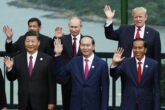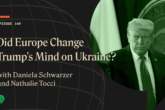February 21, 2022
Russia’s Shock and Awe
Russia appears to be on the verge of launching a major military operation against Ukraine. It has amassed an unprecedented number of troops on the country’s border, and Russian-led forces in the Donbas region of Ukraine have sharply escalated their attacks along the line of contact. Leaders of the Luhansk People’s Republic and the Donetsk People’s Republic, the breakaway regions of Ukraine that Russia has propped up since 2014, have blamed Ukraine for a series of explosions and attempted acts of sabotage, such as a supposed attack on a water treatment facility, that seem to be staged provocations. It appears as if Russia is engineering a pretext to invade Ukraine by conducting a false flag attack—blaming Kyiv for actions Moscow in fact instigated—and alleging that the government of Ukraine poses a threat to Russian speakers in the country’s east. U.S. President Joe Biden is convinced that Russian President Vladimir Putin has directed the military to move in.
A war between Russia and Ukraine could prove to be incredibly destructive.
Despite all this evidence, Putin could still get cold feet. There is a chance that Russia ultimately opts not to launch a new war. But if one happens, it would not look like the limited offensives Russia mounted in Ukraine in 2014 and 2015. Those operations resulted in Russia’s seizure of Crimea, established the separatist territories, and forced Kyiv to accept a cease-fire. But these campaigns were never enough to give Russia leverage over Ukrainian politics and foreign policy; indeed, they helped push Kyiv closer to the West. This time, if Russia invades, it would not constrain itself. It would use the bulk of its military resources—ground forces, airpower, attack helicopters, powerful missiles, and its navy—in a violent, open conflict. It would roll across large parts of Ukraine, not just the east, and try to seize the capital with the goal of installing a pro-Russian government. Such ambitions would require an extensive initial operation, followed by the entry of additional forces that could hold territory and secure supply lines.
Read the full article from Foreign Affairs.
More from CNAS
-
A New Era of Strongman Rulers Is Upon Us
The consequences of strongman rule also seep into the fabric of economies and everyday life....
By Andrea Kendall-Taylor
-
Did Europe Change Trump's Mind on Ukraine?
The Trump administration made a major move this week in its announcement of sanctions on major Russian oil companies Rosneft and Luke Oil, along with 31 subsidiaries. This fol...
By Andrea Kendall-Taylor & Jim Townsend
-
Transatlantic Security / Energy, Economics & Security
Bloomberg Tech | Day 1 | Opening Night DebateGeoffrey Gertz, senior fellow, joined Bloomberg Tech's opening night debate and attempted to answer the question “Is Europe Too Late to Compete in the Chip War?” The U.S. and ...
By Geoffrey Gertz
-
A Tale of Two Russias: Views from Former Intelligence Officers
Four years into its war in Ukraine, Russia continues to escalate attacks on the Ukrainian population while also dialing up its hybrid campaign against Europe. In the last six ...
By Andrea Kendall-Taylor, Jim Townsend & Peter Schroeder




